Minimalism - Space. Light. Object.
6 Bayfront Avenue
Level 3 @ ArtScience Museum
1 Saint Andrew's Road
Level B1, Level 1, Level 2, Level 3 @ National Gallery Singapore
https://www.minimalism.sg/
 |
| Mega Death By Tatsuo Miyajima |
Opening Hours:
Daily 10am - 7pm
Temporary Exhibition 16 November 2018 - 14 April 2019
Admission Fees (In SGD $):
Adults: $24 or $16
The lower prices stated here are for Singapore Citizens & PR
Estimated Visiting Duration:
2 - 7 Hours
List Of Star Attractions (Must See):
Moving Neon Cube By Jeppe Hein
4 Forms Measuring 600 x 57 x 52 cm Constructed To Be Held Horizontal To A Wall By Santiago Sierra
+ And - By Mona Hatoum
+40m By Tan Ping
Horizontal Depth By Frederik De Wilde
Seu Corpo Da Obra By Olafur Eliasson
Mega Death By Tatsuo Miyajima
Impenetrable By Mona Hatoum
Neon Light Installations By Peter Kennedy
Untitled Optical Perception By Robert Irwin
Void By Anish Kapoor
Room For One Colour By Olafur Eliasson
Sol LeWitt Upside Down Cubes By Haegue Yang
Sunflower Seeds By Ai Weiwei
List Of Main Attractions (Good To See):
Cargo By Sopheap Pich
Woodcuts On Paper By Tan Ping
Ring Of Stones By Richard Long
Still Life By Zhou Hong Bin
Sunday, Thursday, Friday By Carmen Herrera
To Reflect An Intimate Part Of The Red By Anish Kapoor
Monument For V. Tatlin By Dan Flavin
Aluminium & Transparent Synthetic Polymer Resin By Donald Judd
Incomplete Open Cubes By Sol LeWitt
Mirror Glass & Wood Cubes By Robert Morris
Prop By Richard Serra
(This And That) Put (Here And There) By Lawrence Weiner
16-Sided Open Polygon By Walter De Maria
Zen For Film By Nam June Paik
Blank Paper By Liu Jianhua
Untitled Golden By Felix Gonzales-Torres
Work No. 312 A Lamp Going On And Off By Martin Creed
List Of Other Attractions (For A Complete Experience):
Drumming By Steve Reich
Pillow For The Dead By Rei Neito
Gay Guerrilla By Julius Eastman
Brass Boxes By Donald Judd
My Galleries VI - All Identical? By Chen Shiau-Peng
Untitled 85-033 By Donal Judd
Queen Of The Night I By Barnett Newman
Tomlinson Court Park By Frank Stella
Wall Drawing #338 By Sol LeWitt
(3R+2B)SW By Rasheed Araeen
Intervals I Plus II By Kim Lim
Kite Traps By Roberto Chabet
Male I By Kazuko Miyamoto
Oneness Of Concrete & Oneness Of Wood By Jiro Takamatsu
Untitled Leaning Triangle By Fred Sandback
Catastrophe By Midori Takada
Ton Of Tea By Ai Weiwei
Thought-Provoking Minimalist Artwork - Is It The Object, Or The Void?
(Ratings: On a scale of 1 to 10, with 1 = Worst and 10 = Best)
Overall: 8
Visited: Apr-2019
.....
The Minimalism art movement came to prominence in the 1960s, and was one of the most influential art movements of the era. Characterised by repeated geometric forms (often in series), and its use of industrial processes and materials, Minimalist artists striped artworks down to their most essential elements, creating direct, unmediated experiences between the viewer and the artwork, in a specific space and time. The unique Minimalism - Space. Light. Object. showcases over 150 influential artworks by over 100 artists, spread across 2 venues. The ArtScience Museum exhibition explores form, colour, and the notion of emptiness; while the National Gallery Singapore exhibition traces the emergence and development of Minimalism.
The artwork showcased at Minimalism - Space. Light. Object. spans the typical, such as paintings, sculptures, videos, photographs, or hand-made objects, but also includes music, transformed spaces, and performances. Each artwork is accompanied by a short descriptive write-up; it's highly encouraged to spend a little time reading these, in order to better appreciate the artwork. Else, simply performing a cursory look won't allow you to fully appreciate and maximise enjoyment of the visit.
There's a sense that Minimalism - Space. Light. Object. has themes of spirituality, industrialisation, rebellion, and simplicity; encompassing of form, colour, object, space, time, and material. It embodies everything, yet embodies nothing. It is the inclusion of, and also the exclusion of. Vastly open to self-interpretation, the artwork at Minimalism - Space. Light. Object. engages both mind and body.
If you're planning a visit to Minimalism - Space. Light. Object., do note the admission price is SGD $24 per adult, or SGD $16 for adult Singaporeans, and allocate between 2 - 7 hours for viewing. General photography is allowed, but not flash photography. Because the exhibition is split across 2 venues, good walking shoes and transportation costs should be considered. There is also a specific order of viewing, you'll have to begin at the ArtScience Museum, where you're supposed to collect an entry pass for the National Gallery Singapore. While children are allowed in, the overall environment is not child-friendly, and the exhibits are mostly static, so kids may get bored.
.....
Horizontal Depth By Frederik De Wilde: This piece intersects art, science, and technology. Working with NASA, he engineered a new colour in 2010 - proved to be the 'blackest black' in the world. Coated in this 'blackest black' colour, the carbon nanotubes of this artwork capture light at all frequencies. When looking at this, viewers are literally looking into nothing; a void space - the closest approximation of emptiness that is possible to experience on this planet. This encounter with the void is like staring into a black hole; no matter which angle you examine it from, it looks like a hole swallowing reality.
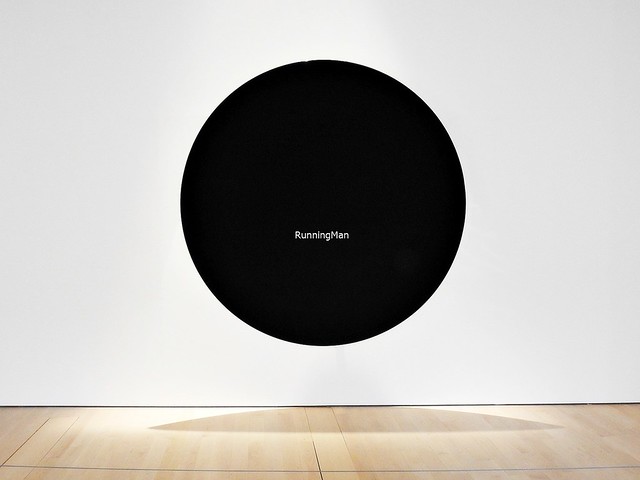 |
| Horizontal Depth By Frederik De Wilde |
+40m By Tan Ping: A visual, conceptual centerpiece of the exhibition. A single line was carved into a block of wood, in one continuous sitting by the artist, over 6 hours non-stop. The wood block was then used to print the line on paper, itself a technical challenge - how to make something of this length (40m) appear unbroken. While one end of the line can be seen and the other end cannot, this suggests endlessness, formlessness, and infinity. It's said the artist was fully immersed during the carving process, channeling all his focus, energy, and concentration into controlling the speed and movement of his carving knife.
 |
| +40m By Tan Ping |
Monument For V. Tatlin By Dan Flavin: Homage to the utopian ideals of constructivist artist Vladimir Tatlin. The use of fluorescent tubes transforms the surrounding space with light, and resonates with a visually reductive approach to art. This piece references the unrealised, soaring tower, intended to further Marxist propaganda in the early 1900s. The artwork is meant to be an ironic mockery.
 |
| Monument For V. Tatlin By Dan Flavin |
Moving Neon Cube By Jeppe Hein: A playful and ironic reinterpretation of the static Minimalist cubes of the 1970s. The structure uses neon lights, switching on and off in sequence, to make it appear as if the cube is rolling around. In this manner, the piece transcends the ordinary static works of old, becoming a form of performance art. Its complexity of electronics contradict the Minimalist aesthetic, yet it represents the most iconic Minimalist form - the cube.
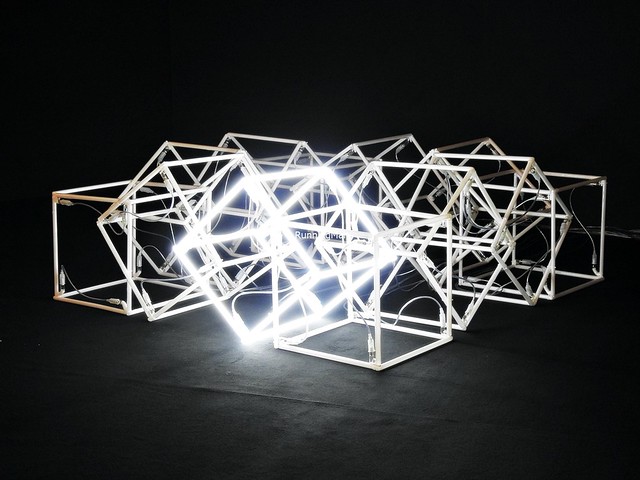 |
| Moving Neon Cube By Jeppe Hein |
Seu Corpo Da Obra By Olafur Eliasson: Art and Science collide in this installation of coloured translucent plastic sheets, framed by wood and spotlights. Exploring perceptions of light and colour, walking through this labyrinth changes one's view and experience of space, depending on your position within this immersive work. As colours glow and deepen around you, the invitation is to consider how we function and see the world - through a variety of different shades.
 |
| Seu Corpo Da Obra By Olafur Eliasson |
Oneness Of Concrete & Oneness Of Wood By Jiro Takamatsu: Each of these works comprise a single material, hollowed out, and then returned to the space from which it came. The focus is on the qualities of the material, exploring its singular identity and its potential to be transformed. The use of a cubic shape and simple raw materials links it to the Minimalist movement, which is undermined by the breaking of its geometric form.
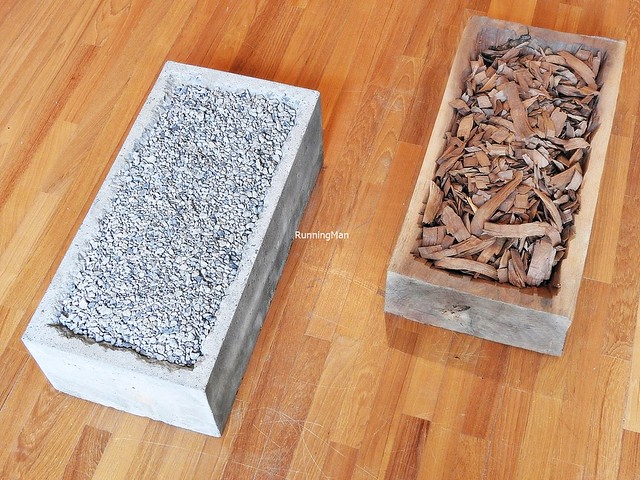 |
| Oneness Of Concrete & Oneness Of Wood By Jiro Takamatsu |
Blank Paper By Liu Jianhua: A cursory glance at this piece suggests that 3 large, empty sheets of paper are mounted on the wall. The curled edges convey an impression of lightness and flexibility. However, its simplicity belies its nature - these are in fact solid pieces of fine white porcelain, shaped to resemble paper. The arrangement of the piece emphasises nothingness, repetition, purity, and simplicity. It invites you to project your own meaning onto it. I think of duality; and of appearing to be one thing on the surface, while actually being something else.
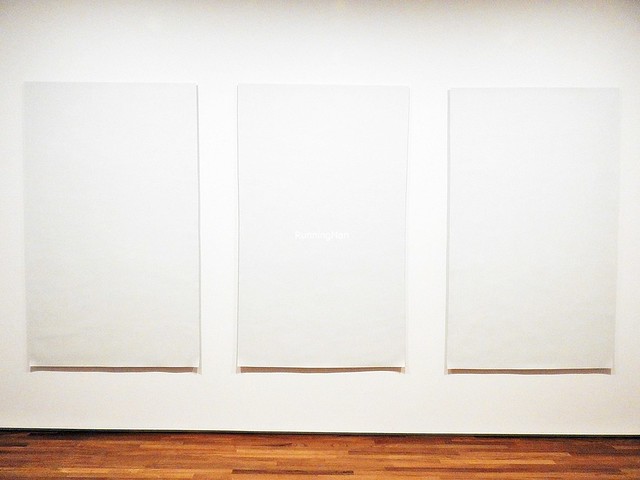 |
| Blank Paper By Liu Jianhua |
Sol LeWitt Upside Down Cubes By Haegue Yang: This piece consists of a set of cubes, made from standard white Venetian window blinds, hung from suspension grids against an ultramarine blue wall, illuminated by spotlights. It references the famed 1960s Minimalist artist Sol LeWitt, and his work with white cubic structures, modularity, and repetition. However, this artist has introduced an element of randomness, as the width and density of the window blinds can be easily changed. By turning the piece upside down and hanging them (instead of placing them on the floor), she challenges the Western male historical canon, with an Asian female contemporary perspective.
 |
| Sol LeWitt Upside Down Cubes By Haegue Yang |
4 Forms Measuring 600 x 57 x 52 cm Constructed To Be Held Horizontal To A Wall By Santiago Sierra: This piece combines performance art with sculpture to create a striking commentary on a labour economy. 8 individuals, hired at minimum wage, shoulder monolithic blocks of wood for an extended period of time. This translates the artistic event into an economic transaction - labour becomes a spectacle to be looked at. By 'delegating' this manual labour to others, the artist is commenting on the inequality of power structures, and the unfairness of economic systems. It also calls to mind the sculptured atlas figures of myth that hold up ancient classical architecture.
 |
| 4 Forms Measuring 600 x 57 x 52 cm Constructed To Be Held Horizontal To A Wall By Santiago Sierra |
Work No. 312 A Lamp Going On And Off By Martin Creed: This feels like the setting of a horror movie. A lamp in an empty room continually flickers on and off each second. The works draws acute attention to the surrounding space, its stillness and emptiness. As they say, it's all in your mind.
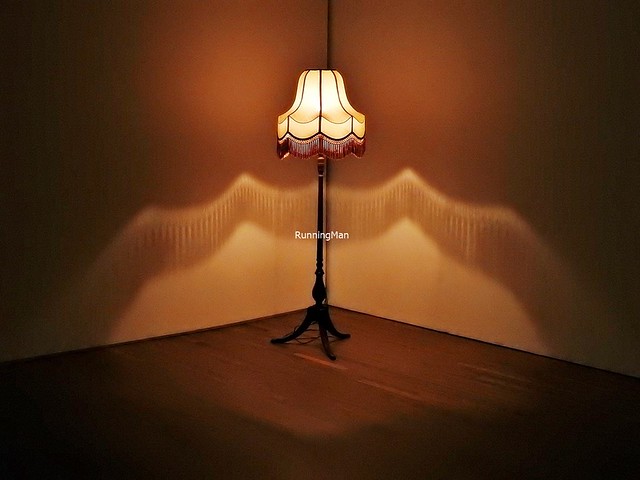 |
| Work No. 312 A Lamp Going On And Off By Martin Creed |
Mega Death By Tatsuo Miyajima: This piece comprises 3 walls of LED numbers, spanning the length of a hall, repeatedly counting down from 9 to 1. The number 0 is replaced by a brief period of darkness, before the cycle begins again. The artist terms this "the radiance of human life", a piognant commentary of a civilisation's life cycle of birth, death, and renewal. As the numbers slowly tick down, each flash suggests that even technology cannot prevent the passage of time.
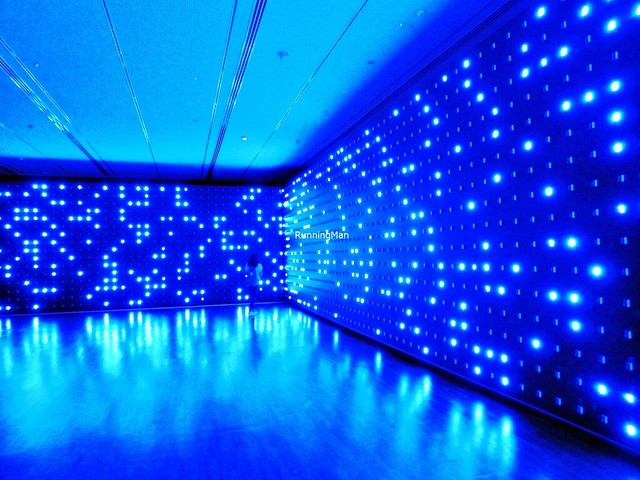 |
| Mega Death By Tatsuo Miyajima |
Cargo By Sopheap Pich: Based on a 20-foot shipping container at 1:1 scale, made with local Southeast Asian materials including bamboo, rattan, and metal. This orderly, geometric woven structure shares the mathematical logic of early Minimalist grids and cubes. The container is a symbol of global maritime trade, but where real containers are opaque and obscure their contents, the artist's interpretation allows viewers to see right through - a statement of transparency in these uncertain global times.
 |
| Cargo By Sopheap Pich |
Impenetrable By Mona Hatoum: This installation appears frail and delicate from afar. However, up close, this cube composed of barbed wire repels instead. The contradiction is a central theme of the artist; she subverts expectations, surfaces our assumptions, and highlights the potential for violence in common everyday structures and actions.
 |
| Impenetrable By Mona Hatoum |
(3R+2B)SW By Rasheed Araeen: This wall-mounted lattice structure was designed from the artist's desire to create the most minimal, structurally stable open form. Constructed with acrylic plastic on wood, the diagonal struts hold the components together. Informed by industrial architecture, the artwork has elements of Islamic geometry, optimism, and avoidance of hierarchy - all influences from the time period of the early 1900s, when his country broke away from colonial rule.
 |
| (3R+2B)SW By Rasheed Araeen |
Sunflower Seeds By Ai Weiwei: This work uses the concept of seriality to critique the nature of manufacturing. On a cursory glance, this field of ceramic sunflower seeds looks mass produced. However, every single one of these is actually unique - all handcrafted by artisans. This dedication to craft challenges the "Made in China" narrative, and the perception of low quality, cheap, mass production. It also symbolises many different individuals coming together to contribute to the community.
 |
| Sunflower Seeds By Ai Weiwei |
.....
.....


CONVERSATION